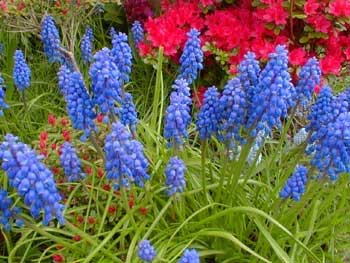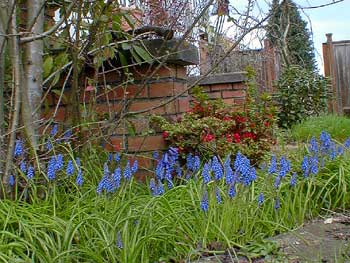 Old-fashioned
Old-fashioned
Grape Hyacinths
"Shaded hyacinth, alway
Sapphire queen of the mid-May."
-John Keats,
1795-1821
1795-1821
We did not personally plant these grape hyacinths (Muscari botryoides) but there are a great many naturalized in one our yards. Both Scilla & Muscari were planted who knows by whom or how long ago, under an overhanging hawthorn tree & under a large unnamed Rhododendron that blooms twice a year, & all around the base of a Hino Crimson Azalea.
The April photo shows the bright blue Grape Hyacinths swollen to maximum size, with a lower limb of the Hino Crimson sharply contrasted in the background. If you look closely in the lower right hand corner, you can barely make out some very pale blue grape hyacinths hiding behind the blue. These are Muscari armeniacum muscari 'Valerie Finnis' which got started a couple weeks later than M. botryoides & haven't stuck their heads up very far. The second photo was taken a couple weeks earlier, in March, when there was hardly yet a sign of 'Valerie Finnis.'
Undernearth shrubs is an ideal location for grape hyacinth, which seems to do just dandy where more fragile flowers might be unable to compete with the roots of woody shrubs for sufficient water, or which would require more sunlight.
If you inspect the grape-bunches closely you realize the individual grapes are actually six-petalled flowers hanging like bells, but the petals only open at the very bottom or are nearly closed like a purse that closes with a pulled string. They are generally a rich purply blue, hence their identification with grapes. There is a natural white strain of the same species known as Pearls of Spain, but the majority Grape Hyacinths are blue or purple.
 M. botryoides's lily-grass appears in Autumn, providing rich green areas through the winter. They bloom late winter & spring, after which even the dense bright foliage dies back to the ground for summer. The bulbs reproduce themselves rapidly & are easily dug up for division; plus the seeds are self-sowing for ever-increasing thickets of lily-grass. Many of the bulbs aren't fully buried in the ground when left to their own devices, yet they thrive. They have even seeded themselves into cracks of a sidewalk & not suffered.
M. botryoides's lily-grass appears in Autumn, providing rich green areas through the winter. They bloom late winter & spring, after which even the dense bright foliage dies back to the ground for summer. The bulbs reproduce themselves rapidly & are easily dug up for division; plus the seeds are self-sowing for ever-increasing thickets of lily-grass. Many of the bulbs aren't fully buried in the ground when left to their own devices, yet they thrive. They have even seeded themselves into cracks of a sidewalk & not suffered.It is a weed in central Europe which explains its hardiness. Granny Artemis & I have become more than a little fond of it, & we have been happily been extending the varieties of grape hyacinths, including the "Valerie Finnis" barely glimpsed in the above photo, & others such as M. comosum 'Plumosum' the Plumed Muscari; M. latifolium a two-tone grape hyacinth, & M. pallens the Pastel Muscari, all of which begin blooming a little later than M. botryoides.
In some areas I've removed them in the course of planting other things. To avoid accidentally spreading them to other areas while moving dirt about, any dirt I've removed went out to the roadside into a low-maintence area, so now there are dense thickets of them on the road, brilliantly blue from March through May.
Since about half their bulbs are right at the surface, we have let them do as they please then used a bulb-hole puncher in some spots to set other types of bulbs a bit deeper, so that in varying seasons we see different blooms in the same location, especially lanterned Checkered Lilies springing up from amidst the grape-hyacinth's lily-grass later in spring.
They do look like scaled-down humble versions of the showy hybridized Hyacinthus orientalis. The name Muscari alludes to their starchy-sweet odor which in some species approaches the odor of musk. Though a bit small to easily notice the scent unless you pick one & practically stuff it up your snout, bees certainly notice them, as grape hyacinth produces lots of nectar. Bees have larvae to feed well before most flowers are blooming, & can have a hard time feeding their young early in the year; the grape hyacinth is ideal for bees' pre-spring nectar requirements.
The explosion of late winter snow crocus blossoms may be short-lived, but the grape hyacinth last & last, the first few blooming by late February, all of them abloom in March, & swollen to maximum bloom in April. Blooms last into May in the lightly shaded locations.
Grape Hyacinths have been gardened for centuries & were very familiar to the Elizabethans, but were likely gardened even in the Greek & Roman ages. An Anglo-Saxon translation of Dioscorides preserves an otherwise forgotten myth of their origin, the first grape hyacinths having sprung from spilled dragon's blood on a forested mountain peak.